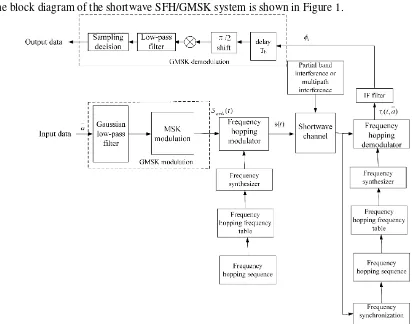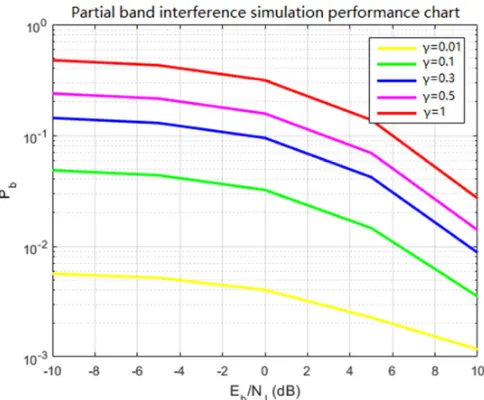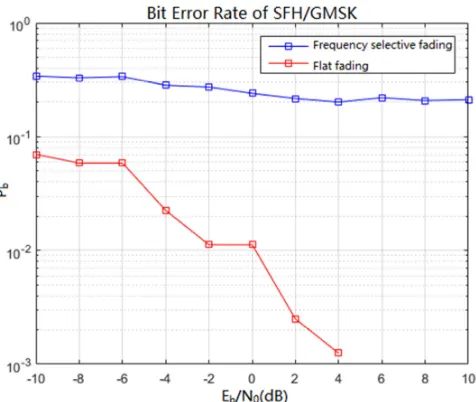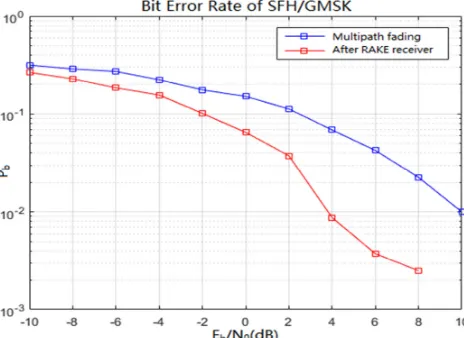2018 International Conference on Computer, Electronic Information and Communications (CEIC 2018) ISBN: 978-1-60595-557-5
Research on Anti-Jamming Performance of GMSK in Shortwave
Frequency Hopping
Hong-xi ZENG, Guo-bao RU
*and Liang-cai GAN
School of Electronic Information, Wuhan University, Wuhan Hubei 430079, China
*Corresponding author
Keywords: GMSK, Shortwave, Slow frequency hopping, Partial frequency interference, Multi-path.
Abstract. In this paper, we first analyze the performance of GMSK against partial-band interference in short-wave and slow-frequency hopping. Numerical simulation results show that
when the value is different, the BER of the BER varies with the SIR. When is small, the BER
of SFH/GMSK is smaller than that of SFH/MFSK under the same conditions. When is large, the
BER of SFH/GMSK is smaller than that of SFH/BFSK, but larger than the BER of SFH/4FSK. Then we analyze the anti-multipath interference performance of GMSK in short-wave slow frequency hopping, and choose Rayleigh fading channel and Rice fading channel for simulation. The flat fading and frequency selective fading are used in Rayleigh fading channel respectively. The simulation results show that in Rayleigh multi-path fading channel, SFH/GMSK anti-multipath fading performance is better than SFH/MFSK; in Rician channel, the larger the K value is, the smaller the error rate is. Finally, three kinds of diversity combining methods are added to a frequency-selective fading SFH/GMSK short-wave channel system. The simulation results show that compared with the bit error rate of multipath channels, by combining multipaths the system performance of bit error rate can get 2dB improvement.
Introduction
Frequency-hopping communication has good anti-interference, low probability of interception and strong networking capability. It has been greatly developed in the military field. Radio frequency-hopping technology has been widely used in military communications and has greatly improved anti-interception and anti-interference capabilities of military equipmen[1]. However, in modern warfare, not only voice information is required to be transmitted, but also a large amount of data and video information are required to be transmitted at a high speed. Since short-wavelength channels have characteristics such as multi-path effect and band limitation, conventional short-wave frequency hopping systems employ MFSK and other modulation methods for high-speed data. Transmission can no longer meet the demand. Gaussian minimum frequency shift keying (GMSK) method has the advantages of good spectrum utilization efficiency, good anti-jamming performance,
and non-coherent demodulation, so it has been widely used in mobile communications[3]. Under the
fixed channel bandwidth, using GMSK modulation can give higher data transmission rate than
using FSK or MFSK modulation[2]. Therefore, this paper will explore the anti-jamming
performance of GMSK in short-wave frequency hopping.
In this paper, the principle and implementation method of GMSK/SFH for slow frequency hopping short-wave communication system based on GMSK modulation are presented first, and a basic mathematical model is proposed. The BER performance of adding frequency hopping and not adding frequency hopping is analyzed. Then we verify that frequency hopping communications has good anti-jamming capability as follows. Firstly, the 1-bit DPD demodulation algorithm based on sampling decision and the 1-bit DPD demodulation algorithm based on Viterbi algorithm are
compared and analyzed. The BER performance is obtained through numerical simulation.Secondly,
system performance, the degree of influence is given by a model based on ideal compensation at the receiving end. The simulation results show that the system's BER performance is significantly improved.
System Model of SFH/GMSK
[image:2.612.90.505.140.465.2]The block diagram of the shortwave SFH/GMSK system is shown in Figure 1.
Figure 1. Shortwave SFH/GMSK system.
In the figure, the information modulation uses the GMSK method to demodulate the 1-bit
differential phase demodulation scheme used. Suppose that = (… , , , , , , … ) and
send ∈ {+1, −1} in the message sequence[4]. After the GMSK modulated signal ()
becomes[3]
() = 2EbTcos2πfct+
π
2T ∑ angτ-nT
∞
n=-∞ !dτ
∞
-∞ ! = 2#$ cos [2+,% -t + ∅(t, )] (1)
where #$ is the symbol energy, % is the symbol width, ∅(t, ) is the information sequence, is the modulation phase function, g(t) is the unit rectangular impulse response of the Gaussian low-pass filter with the expression[2].
2() = 3 4 567
√9 −
:7!; − 3 4 567
√9 +
:7!; (2)
with 3() =
√ 5exp (−? )@?2 A
B .
Here C$%$ is the normalized 3dB bandwidth of the Gaussian filter. Its value affects the spectral
characteristics of the GMSK modulated signal. The smaller the value of C$%$, the more severe the
D() = 2#$
%
∑AGHAE( − F$%)cos[2+,Gt + ∅(t, ) + IG] (3)
where F$ is the number of symbols in each hopping interval, E() is a unit rectangular pulse of width F$%, ,G is the carrier frequency in the Jth hopping interval, and IG is the Jth hop, the initial phase of the carrier within the frequency interval, a random variable whose value is uniformly distributed within [0, 2π].
The signal D() passes through the shortwave channel and is sent to the receiver. Assuming that
the two sides of the frequency hopping communication completely achieve synchronization, and considering only the influence of the phase information and the phase components introduced by the additive white Gaussian noise (AWGN) of the short-wave channel, the solution of the D() signal in the Jth frequency hopping interval, the jump signal is[3]
KG(, ) = 2#$ cos[2+,% -+ ∅L(, )] JF$% ≤ ≤ (J + 1)F$% (4)
where ∅L(, ) = ∅(t, ) + IG + NO(), with NO() being the phase component introduced by additive white Gaussian noise. The KG(, ) signal is first filtered out of the out-of-band noise by the receive filter, then multiplied by the original KG(, ) signal after delay and phase shift, and finally passed through a low-pass filter to obtain a 1-bit DPD. The output is[3]
P() = #$
%
sin[2+,-% + ∅L(, ) + ∅L( − %$, )]
JF$% ≤ ≤ (J + 1)F$%. (5)
The final output signal P() is sampled by the sampler.
Analysis of Anti-jamming Performances
Anti-partial Band Interference
Frequency hopping communication realizes communication by changing the carrier frequency determined by the sender and the receiver and carries the frequency hopping of signal messages in a wide frequency band against communication interference[6]. Part of the band interference refers to the situation when the interferer concentrates the interference power of the jammer on a certain part of the frequency band of the frequency hopping signal[7]. The effect of partial band interference on the frequency hopping system and the bandwidth of the interference are related to the percentage of
the entire frequency hopping bandwidth[7].. Interleaving and error correction coding have a certain
effect on the frequency-hopping system against partial-band interference, but when the frequency-hopping system is occupied by a certain proportion of the number of channels that are interfered, the curve of BER varies with signal-to-noise ratio. The exponential relationship becomes a linear relationship, and its ability to resist interference is greatly reduced, which in turn causes serious interference to the frequency hopping system and causes signal interruption. Therefore, the effect of the use of the partial band interference on the frequency hopping system is better than that of the full band interference.
In the following equation, F: is the total power spectral density generated by the background noise and interference, F is the power spectral density of the background white noise, and FT is the power spectral density of the interference noise, F: = F+ FT, is the signal average power, and UB is the thermal noise power total signal to noise ratio[8]
V7
WX=
V7
WYZW[=
:7 \] ^_Z^_\[
=:7`_
When bc = d$, %$bc= 1,β =V7
WY is the signal-to-noise ratio (the ratio of the average power of the signal to the power of the background noise) and ε =WV7
[ is the signal to interference ratio (the ratio of the average power of the signal to the power of the interference). Bring these two terms into Equation 6 to get
V7
WX=
g hZgi =
j∙l
jZl. (7)
Then the error rate of partial band interference is[8]
Um = (1 − )Um+ Um = (1 − )12 exp n−12U Bo +
1
2 exp n−12F:o
= (1 − ) exp p−βq + exp p−rZsr∙sq, (8) where =``[
tt, which is the proportion of the frequency bandwidth of the frequency band in the frequency hopping system.
Anti-partial Band Interference
According to the channel frequency selection characteristics, multipath channels can be divided into flat fading channels and frequency selective fading channels. In general, multiple signals arrive at the receiver first and then have a relative delay. If these relative delays are much less than the time of one symbol, it can be considered that the multiple signals arrive at the receiver almost at the same time. In this case multipath will not cause interference between symbols. This decline is called flat fading. The flat fading channel condition is
CL ≪ C- %≫ wx, (9)
where % is the signal period, CL is the signal bandwidth, wx is the rms delay spread of the signal, and C- is the relevant bandwidth of the multipath channel. If the relative delay of the multiple signals is not negligible compared to the time of one symbol, then when the multiple signals are superimposed, the symbols at different times will overlap, causing inter-symbol interference. This fading is called frequency-selective fading and the condition of frequency-selective fading channels is
CL > C- % < wx. (10) From the frequency shift point of view, different frequency components experience different fading. From the time domain, the channel delay is extended more than the symbol period. Through the combined effect of multipath effects, the receiving end obtains several resolvable paths. The path contains several unresolvable paths. Therefore, with the same signal sent, the receiver will receive a number of different delay signals with the same signal arriving at different times, which will cause interference and result in a serious distortion or inter-code interference. From the above analysis, we conclude that the frequency selective channel is composed of multiple flat fading channels with different delays.
As the complexity of the channel increases, the number of multipaths also increases. The larger the number of multipaths, the greater the system error rate[8] . In this paper we only consider multipath 3 channels.
Figure 2. Frequency-selective Rayleigh fading channel simulation model.
The Rayleigh fading experienced after the delay can be achieved by combining multiple
independent flat fading channels. The impulse response of the multipath channel is[9]
{(?, ) = ∑}~9H |U929()w( − ?9), (11)
where = 0, 1, . . ., − 1 is the number of multipaths, 29() is the th delay component, a
complex Gaussian process whose power spectrum is the Doppler spectrum of the -path, and U9 is
the power of the first path delay. The signal after passing through the channel can be expressed as[9]
P() = ∑}~9H |U929()( − ?9), (12)
where 29() is a flat fading channel. To establish a frequency-selective fading channel, one must first generate a mutually independent flat fading channel 29() that obeys the Rayleigh distribution.
Rice Fading Channel. In the wireless channel, the Rice distribution is a type of function distribution used to describe the time-varying characteristics of the received signal envelope. Its probability density function is
U(K) = exp p− ZL
q ∙ p∙L q, (13) where K is the envelope of the received signal, w is the variance of the multipath component, D is the power of the main signal, and is the first 0th-order modified Bessel function. The Rice distribution has a very important parameter K (Rician factor) which represents the ratio of the power of the main signal to the variance of the multipath component and is used to measure the effect of the dominant path
= 102 L. (14)
when D = 0, K = −∞dB, the multipath fading is the largest and the Rice distribution becomes the
Rayleigh distribution. When K = +∞dB, there is no fading.
Numerical Simulation Analysis
In this paper, a shortwave SFH/GMSK simulation system model is established using MATLAB, and the performance of a 1-bit DPD demodulation scheme based on a sampling decision decoding algorithm is numerically simulated.
The parameters used in the SFH/GMSK simulation model are as follows: carrier frequency is 32 kHz; C$%$ is 0.5; modulation index is 0.5; C$ is the normalized 3 dB bandwidth of the Gaussian filter; the frequency hopping frequency is 32; the center of frequency hopping frequency is 18MHz; frequency hopping bandwidth is 1MHz; skip rate is 40 hops/s; there are 8 symbols per hop.
Figure 3. SFH/GMSK joins partial-band interference BER.
As can be seen from Figure 3, as the SIR ratio increases, the SFH/GMSK bit error rate will decrease. The larger the γ value, the greater the bandwidth occupied by the interference band, the stronger the interference effect to SFH/GMSK, the larger the error rate. When γ ≥ 0.3, the error rate for the SIR less than 0 is greater than 0.1, and the interference effect is better at this time. Therefore, if we want to achieve a better interference effect, the interference noise band accounts for more than 30% of the entire frequency hopping bandwidth. It can also be seen from the figure that the trend of the five curves with different γ values along the signal to interference ratio is basically the same,
and the change in the γ value does not affect the trend of the SFH/GMSK bit error rate curve. When
the signal-to-interference ratio is less than -5 dB, the BER changes little, so it can be seen that for each partial band interference factor γ, there is a worst BER which increases the interference noise. When the power does not increase, the bit error rate increases. Therefore, after the interference noise reaches a certain value, the effect on the interference is not significant. By comparing with[7], it can be seen that the error rate of SFH/GMSK is smaller than that of FH/BFSK and SFH/4FSK when the interference factor is 0.1; the error rate of SFH/GMSK is smaller than SFH/BFSK when the interference factor is 0.5. The error rate of SFH/GMSK is smaller than SFH/BFSK but bigger than SFH/4FSK when the interference factor is 1.
Figure 4. BER of SFH/GMSK in flat fading channels and frequency selective fading channels.
[image:7.612.200.407.400.581.2]From Figure 4, we can see that with the increase of SNR, the bit error rate of SFH/GMSK in flat fading channel and frequency selective fading channel is gradually reduced. The curve of frequency-selective fading can be obtained by comparison with Figure 5-4 in[10]: the BER of SFH/GMSK in the frequency selective fading channel is slightly smaller than the BER of SFH/MFSK. The flat fading channel is compared with Figure 5-12 in [10]. The error rate of SFH/GMSK in the flat fading channel is much better than the BER performance of SFH/MFSK. Therefore, we can conclude that the performance of SFH/GMSK anti-multipath fading is better than that of SFH/MFSK.
Figure 5. BER Rate of GMSK/SFH Rice Channels with Different K Values.
The BER of the GMSK/SFH in the Rice fading channel with different K values is shown in Figure 5. The Rice fading channel parameters are as follows: the amplitude fading weighted by the RICE distribution, the power distribution values: 1, 0.05, 0.05; the delays are 0, 2Tc, 3Tc, where Tc = 0.5ms; the maximum Doppler shift is 160Hz. The figure shows that with the increase of SNR, the BER of GMSK/SFH decreases. When the SNR is constant, the larger the K value is, the smaller the BER is.
when the SNR value is less than 0, the BER performances of the three diversity combining modes are approximately equal. And when the SNR value is greater than 0. At the time, the BER performance of the maximum ratio merging method among the three diversity combining methods is the best, with the equal gain combination being the second and the selective merging method the worst. From the simulation results, it can be seen that when the signal-to-noise ratio is too small, the BER is mainly affected by the SNR. Using different diversity combining methods will not play a significant role in optimizing the BER performance when the SNR is reached. At a certain value, the diversity combining mode will play a certain role in optimizing the BER performance. When the SNR is large enough, the channel conditions are better at this time: the impact of noise is small, and the system's BER performance is small. Even better, the diversity combining method at this time will also not play a significant role in improving system performance.
Figure 6. BER of SFH/GMSK in different diversity combining modes after passing through multipath channels.
Figure 7. BER of SFH/GMSK over multipath fading channels and through RAKE receivers.
Figure 7 shows the bit error rate of SFH/GMSK over a multipath channel and through a RAKE receiver incorporating a maximum ratio. As can be seen from the figure, the BER performance of the SFH/GMSK after passing through the multipath channel can be significantly improved after passing through the RAKE receiver.
Conclusion
[image:8.612.189.421.429.598.2]further improve the system performance of GMSK/SFH after passing through multipath channel. For partial-band interference, when the interference factor is small, the BER of SFH/GMSK is smaller than that of FH/MFSK; when the interference factor is large, the BER of SFH/GMSK is smaller than the BER of FH/BFSK. However, the BER of SFH/GMSK will be larger than the FH/4FSK bit error rate. Overall, SFH/GMSK outperforms FH/MFSK when it passes short-wavelength channels.
Acknowledgement
This research was financially supported by the National Natural Science Foundation of China (61671333).
References
[1]Mei Wenhua, Wang Shubo, Qiu Yonghong, et al. Frequency hopping communication [M].
[2]Peng Weijun, Song Wentao, Luo Hanwen. Application and Performance Analysis of GMSK in
Frequency Hopping Communication[J]. Journal of Communications, 2000(11):41-47.
[3]Peng Juhong, Zhao Maotai, Gan Liangcai. Performance analysis of differential phase
demodulation scheme for shortwave SFH/GMSK system[J]. Chinese Journal of Radio Science, 2004, 19(6): 776-780.
[4]Li, Yi Bing, X. Y. Bi, and Q. Yin. "Performance analysis of GMSK with limiter Discriminator
detection in the slow frequency hopping system." Iet International Conference on Wireless, Mobile and Multimedia Networks IEEE, 2009: 1-3.
[5]Yu Chen; Zhongyu Li; Peng Liu; Song Liu." The BER performance comparison of MSK and GMSK Schemes for short-range visible light communication" in 2017 IEEE 9th International Conference on Communication Software and Networks (ICCSN), 2017: 611-614
[6]Wang, Z. & Hu Y.M., Analysis on The Influence of Partial Band Jamming on FH
Communication System. Shipboard Electronic Counter Measure, 35(6), pp. 36-39, 2012.
[7]Qing Cheng, Song Xuerui. Research on Anti-interference Performance of FH/MFSK System[J].
Information and Communications, 2009, 22(06):27-30.
[8]Wang Zhuang, Yu Guowen, Hu Yiming. Analysis of the effect of partial band interference on frequency hopping communication systems[J].Shipboard Electronic Countermeasure, 2012, 35(06):36-39.
[9]Ghnimi S, Rajhi A, Gharsallah A. BER perfermance of GMSK modulation under radio Mobile
propagation environments[J]. 2011:305-308.
[10]Tian Xiaowen. Simulation Study of Slow Frequency Hopping Communication System in
Multipath Fading Channels[D]. Southwest Jiaotong University, 2011.
[11]William H. Tranter, Desmond P. Taylor, Rodger E. Ziemer, Nicholas F. Maxemchuk, Jon W. Mark, "GMSK Modulation for Digital Mobile Radio Telephony" in The Best of the Best:Fifty Years of Communications and Networking Research 1, Wiley-IEEE Press, pp. 223-229, 2007.
[12]Bauer I, Sisul G, Modlic B. Modeling of GMSK Communication Systems for Educational
Purposes[C]// International Symposium Elmar-2006 Focused on Multimedia Signal Processing and Communications. IEEE, 2007:267-272.
[13]Han J S, Kim M J. Quadrature multiplexed Gaussian minimum shift keying[C]// International




